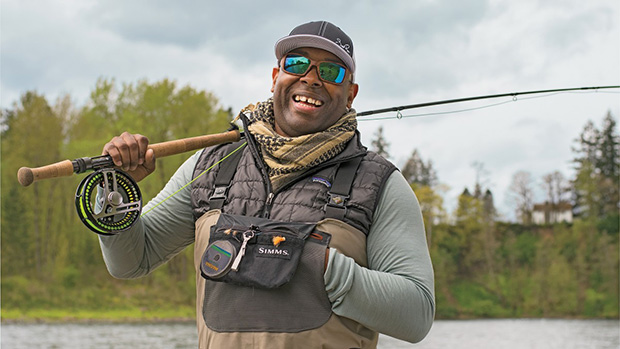
Chad Brown put down a gun and picked up a fly-fishing rod. The Navy veteran turned gear designer now wants kids and vets to heal each other on the great American waters that saved his life.
By: Patrick Symmes
So an Irish American, a Mexican American, an African American, an Asian American, and an Irish-Ukranian-Filipino American walk into a bar. Actually, it’s a breakfast bar. It’s zero dark thirty on a cold January morning, and we’re at a tiny café in Oregon’s Willamette Valley. After some coffee, we are going to chase winter steelhead.
But we don’t actually get to the steelhead, not yet. When the coffee comes, it’s still dark, and still winter. So the most multiethnic breakfast party in the history of Oregon sits down to talk. The sport of steelhead fishing has its own complicated rituals and lingo: there are “big sticks,” or double-handed fly rods, and “the D-loop,” a Jedi-style motion that can fling out a long, heavy line. Regular sticks are just oars. “Double Speys” and “snake rolls” are casting techniques from Scotland; “Scandis” are Swedish lines well adapted to these big Oregon waters.
Let’s deal with the fish right away. About 20 inches long, sometimes much more, steelhead are named for their dull silver, bullet-shaped heads, but depending on their life stage and the time of year, they can be silver-bright from the ocean or passionately colored like mutant rainbow trout. Big and strong, they have the habits of salmon, like going to sea and then, upon their return, refusing to bite a fisherman’s hook. They’re so hard to catch that they’re known as gray ghosts.
“You hear some anglers call them unicorns,” says Chad Brown, the black guy with the deep voice surrounded by fishing buddies. Unicorns are talked about but never seen. Chad’s been fishing for steelhead for four years and hasn’t caught one yet.
Steelhead are the real reason for this gathering, but Chad is the excuse. He’s a U.S. Navy veteran who participated in Desert Storm and Desert Shield, served at Guantánamo Bay, and saw combat during Operation Restore Hope, in Somalia, during the infamous Black Hawk Down era. That he came back with post-traumatic stress disorder is no news in this era—since 2001, more than 378,300 U.S. military personnel have sought treatment for potential PTSD from Veterans Affairs facilities—but he’s also an artist, designer, and educator who believes, he told me at breakfast, “in finding a way to radiate your pain outward to help others.”
Click to read full article
www.outsideonline.com


